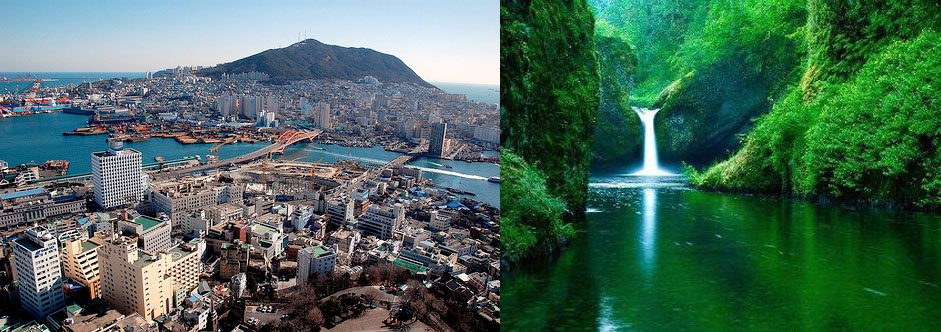Gyeongju
Korea's ancient capital, Gyeongju, is the country's big must-see, and rates as one of the ten most important ancient cultural cities in the world. In among the shops and markets in the modern-day city you'll find abundant relics of its two-thousand-year history, including colossal fifth-century tombs and burial mounds, a seventh-century stone observatory, and the royal pleasure gardens of
Anapji, which were designed in 674 AD. Other quarters of Gyeongju are rich with elegant pagodas and historic wooden Buddhist temples, and numerous trails take you to the slopes of the sacred mountain, Nam-san, which dominates the south of the city.
View images of
Anapji
Hiking in the national parks
South Korea is full of exhilarating national parks, all of which are crisscrossed by clearly marked trails and dotted with good camping spots (and the occasional mountain hut). The cream of the crop is Seorak-san, and in particular Naeseorak (Inner Seorak), an exceptionally tranquil stretch of forested peaks, rivers, waterfalls and Buddhist temples - and some established rock climbs too. Also well worth seeking out are Jiri-san, which boasts a 65-kilometre-long ridge trail and lots of historic temples; the popular and fairly gentle trails of Songni-san; and Bukhansan, which is on the edge of Seoul.
Seoul
South Korea's modern day capital has a reasonable number of sights to keep you entertained for a few days. Most interesting are the five imposing royal palaces, some of which date back to the fifteenth century. Inside the Changdokkung Palace you'll find one of South Korea's loveliest gardens, the Piwon, a beautifully landscaped haven of ponds and pavilions. In the modern part of town, check out the Kimchi Museum, dedicated to fiery pickled cabbage that is South Korea's national dish, browse the cutting-edge Leeum Museum of Modern Art, and spend the evening in the trendy nightlufe district of Sinchon.
Panmunjeom
On the 38th parallel, the 1953 ceasefire line between North and South Korea - a four-kilometre-wide strip of land spiked with guardposts - is still in force today, and the village of
Panmunjeom, which stands on the DMZ just 56km north of Seoul, is a popular day-trip from the capital. Unless you can afford the cost of joining an organized tour around North Korea, this is the closest you can get to the repressive, desperately impoverished totalitarian state. There's no border crossing here (or anywhere between the two countries) but
Panmunjeom attracts busloads of tourists, all of whom required to dress smartly (No jeans, T-shirts or miniskirts) and, if male, to have a respectable haircut!
View images of
Panmunjeom
The KoreanFolkVillage
It may sound like a coach tour nightmare, but the Korean Folk Village is well worth a day-trip from Seoul, especially if you've not got time to explore the rest of the country. A reconstruction of a typical nineteenth-century village, it's complete with Buddhist temple, Confucian school, pottery and weaving workshops, blacksmiths and traditional farmhouses. The people you see in the village do actually live and work there, even if they might look like actors dolled up in traditional outfits.
Jeju-do
This southern island has maintained traditions that have long disappeared from the mainland and is now a popular tourist destination as well as a favorite with local honeymooners. Highlights here include mysterious Easter Island-like statues, hikes to the summit of Halla-san (South Korea's highest volcano), and a seven-kilometer-long lava-tube cave. The climate down here is warmer and wetter that in the rest of the country, but don't come specifically foe the beaches, as you'll find them crowded and disappointingly scruffy
Click here to book flights to South Korea with Zuji The three-hour boat ride from Busan to Yeosu
The three-hour boat ride from Busan to Yeosu
This is one of the most scenic journeys in the country, with fine views of the crenellated coastline and myriad islets. It's so attractive round here that the whole area has been conserved as Hallyo Waterway National Park
The island of Ulung-do
Rugged, remote and starkly beautiful, this tiny volcanic outcrop - accessed by ferry from Samcheck - has hardly any roads and is best explored on foot. It takes two days to walk right round the island, giving you ample opportunity to enjoy the temples. Forested ridges, waterfalls and famous 2000-year-old juniper tree
Taking an open-air bath with a view at Seorak Waterpia
Soak up the glorious mountain vista while wallowing in the natural hot springs at this spa resort in Seorak-san National Park, where you can also bathe in a lemon flavoured pool, go skinny dipping, and brave a shower under a near-boiling waterfall
The fifteenth-century village of Yangdong
Prettily set beside a river and beneath a wooded hill,
Yangdong is of such historic importance that villagers are forbidden to modify or knock down their antique wooden houses, many of which are magnificent structures with sweeping roofs, beautifully carved beams and capacious verandahs.
View Images of
Yangdong
Bargain-hunting at Namdaemun Night Market in Seoul
Opening every night at around 10.30pm and running through till just before dawn, the enormous Namdaemun Market sells everything from handicrafts to saucepans, ginseng to live fish. It's a great place to while away the evening, not least because of all the cheap food stalls that dish up hot snacks through till morning.
Staying in a yogwan
If you're on a budget, make a beeline for these traditional questhouses: they're cheap, family-run, and usually have lots of character. You sleep on a futon on the floor - a special treat in winter when the underfloor heating system kicks in and acts like a huge electric blanket
Snowboarding and skiing at Yongpyong
There are over thirty runs for skiers and snowboarders at this trendy ski resort on the slopes on Mount Balwang, plus floodlit night skiing, a sledging park and cross-country trails. Also holds a snow-sculpture festival in February
Click here to book flights to South Korea with Zuji















































